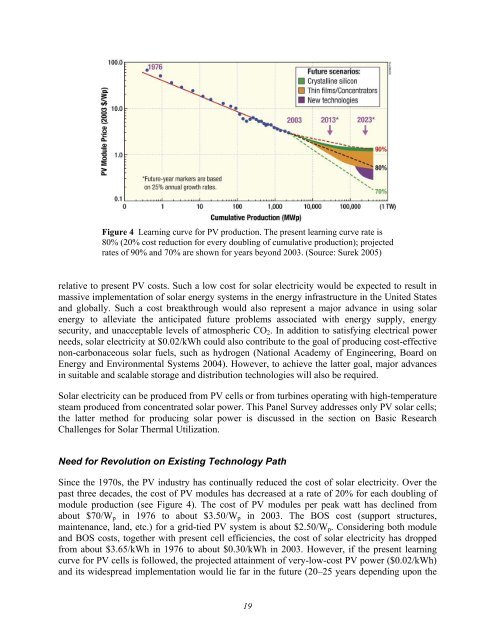Basic Research Needs for Solar Energy Utilization - Office of ...
Basic Research Needs for Solar Energy Utilization - Office of ...
Basic Research Needs for Solar Energy Utilization - Office of ...
Create successful ePaper yourself
Turn your PDF publications into a flip-book with our unique Google optimized e-Paper software.
Figure 4 Learning curve <strong>for</strong> PV production. The present learning curve rate is<br />
80% (20% cost reduction <strong>for</strong> every doubling <strong>of</strong> cumulative production); projected<br />
rates <strong>of</strong> 90% and 70% are shown <strong>for</strong> years beyond 2003. (Source: Surek 2005)<br />
relative to present PV costs. Such a low cost <strong>for</strong> solar electricity would be expected to result in<br />
massive implementation <strong>of</strong> solar energy systems in the energy infrastructure in the United States<br />
and globally. Such a cost breakthrough would also represent a major advance in using solar<br />
energy to alleviate the anticipated future problems associated with energy supply, energy<br />
security, and unacceptable levels <strong>of</strong> atmospheric CO2. In addition to satisfying electrical power<br />
needs, solar electricity at $0.02/kWh could also contribute to the goal <strong>of</strong> producing cost-effective<br />
non-carbonaceous solar fuels, such as hydrogen (National Academy <strong>of</strong> Engineering, Board on<br />
<strong>Energy</strong> and Environmental Systems 2004). However, to achieve the latter goal, major advances<br />
in suitable and scalable storage and distribution technologies will also be required.<br />
<strong>Solar</strong> electricity can be produced from PV cells or from turbines operating with high-temperature<br />
steam produced from concentrated solar power. This Panel Survey addresses only PV solar cells;<br />
the latter method <strong>for</strong> producing solar power is discussed in the section on <strong>Basic</strong> <strong>Research</strong><br />
Challenges <strong>for</strong> <strong>Solar</strong> Thermal <strong>Utilization</strong>.<br />
Need <strong>for</strong> Revolution on Existing Technology Path<br />
Since the 1970s, the PV industry has continually reduced the cost <strong>of</strong> solar electricity. Over the<br />
past three decades, the cost <strong>of</strong> PV modules has decreased at a rate <strong>of</strong> 20% <strong>for</strong> each doubling <strong>of</strong><br />
module production (see Figure 4). The cost <strong>of</strong> PV modules per peak watt has declined from<br />
about $70/Wp in 1976 to about $3.50/Wp in 2003. The BOS cost (support structures,<br />
maintenance, land, etc.) <strong>for</strong> a grid-tied PV system is about $2.50/Wp. Considering both module<br />
and BOS costs, together with present cell efficiencies, the cost <strong>of</strong> solar electricity has dropped<br />
from about $3.65/kWh in 1976 to about $0.30/kWh in 2003. However, if the present learning<br />
curve <strong>for</strong> PV cells is followed, the projected attainment <strong>of</strong> very-low-cost PV power ($0.02/kWh)<br />
and its widespread implementation would lie far in the future (20–25 years depending upon the<br />
19
















